Abstract
Heterocyclic compounds are the cornerstone for active pharmaceutical ingredients. Among heterocycles, isoindoline core occupies a special place, as ten commercial bioactive compounds/drugs contain this skeleton decorated with several functional groups required for optimal receptor binding. These drugs are employed for indications such as multiple myeloma, leukemia, inflammation, hypertension, edema, obesity, and insect control. This review presents the pharmacological activities, mechanisms of action, and chemical syntheses of these commercial bioactive molecules/drugs.
1. Introduction
Heterocycles are organic compounds that consist of at least one atom other than C within a cyclic framework. Most commonly encountered heterocycles usually possess one heteroatom, such as O, N, or S, within five- or six-membered rings. The substitution of a heteroatom in place of C dramatically alters the physico-chemical properties of the heterocycle compared to its corresponding carbocyclic analog. Therefore, it is not surprising that heterocycle-based compounds play a pivotal role in biological processes [1,2]. Some microorganisms and plants are also known to biosynthesize heterocyclic framework-based secondary metabolites as their defense chemicals [3,4]. Given the biological importance of heterocycles, these heterocyclic scaffolds are increasingly used in the development of biologically active molecules for their application as agrochemical, pharmaceutical, and medicinal agents [5].
Among numerous heterocycles, indoline (1) and its isomer isoindoline (1a) are bicyclic frameworks in which a benzene ring is fused with a five-membered nitrogenous pyrrolidine ring (Figure 1). The derivatives of both these rings have been found to display diverse medicinal and biological activities [6,7]. Out of these two heterocycles, 1a is the subject of focus in this review. Although unsubstituted isoindoline (1a) is rarely encountered, substituted isoindolines have garnered special attention from scientists because of their presence in numerous natural and pharmaceutical compounds [8,9,10]. A remarkable range of biological activities, including selective serotonin uptake inhibition, antitumor, diuretic, cytotoxic, hypertensive, and herbicidal activities, mental disorder treatment agents, bronchodilators, N-methyl-D-aspartate agonists, multidrug resistance reversal agents, and fibrinogen receptor antagonists, have been reported from isoindoline derivatives [8,9,10,11]. The most notable and probably most controversial member among these is the infamous thalidomide of teratogenic fame [12].
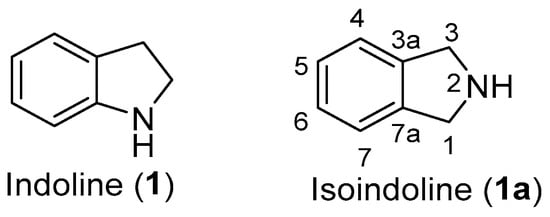
Figure 1.
The chemical structures of indoline (1) and isoindoline (1a) heterocycles.
We have a long-standing interest in isoindoline-based heterocycles. Our group is actively working towards the development of an efficient synthesis of novel molecules possessing isoindoline heterocyclic core 1a. We have recently reported the synthesis of 5-arylisoindolo[2,1-a]quinolin-11(6a H)-ones [13], 2-(2-substituted-aryl)-3-(2-(2-oxopyrrolidin-1-yl)vinyl)isoindolin-1-ones [14], 6,6a-dihydroisoindolo[2,1-a]quinolin-11(5H)-ones [15], and substituted-(2-oxo)-2-arylisoindolin-1-ones [16].
Currently, there are ten approved drugs that contain isoindoline heterocyclic core 1a in their chemical structure (Figure 2), viz. thalidomide (I), pomalidomide (II), apremilast (III), phosmet (IV), lenalidomide (V), indoprofen (VI), chlorthalidone (VII), midostaurin (VIII) mazindol, (IX), and chlorisondamine (X). This review focuses on highlighting the pharmacological properties of these isoindoline-based drugs and their modes of action. The currently known chemical synthesis for accessing these valuable molecules is also presented here. This review is organized based on the oxygenation levels of isoindoline core 1a. Drugs with di-oxygenated isoindoline heterocycles I–IV are discussed first, followed by mono-oxygenated V–IX ones, and lastly the non-oxygenated molecule X is described.
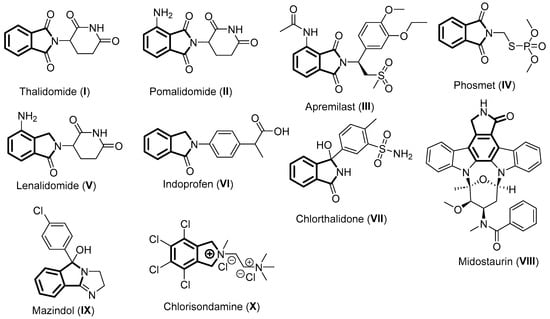
Figure 2.
Chemical structures of clinically used drugs I–X containing isoindoline heterocyclic core Ia.
2. Thalidomide
Thalidomide (I) is one of the earliest known drugs containing isoindoline core 1a. The positions 1 and 3 of isoindoline ring 1a (Figure 1) are oxidized. The resulting skeleton is referred to as isoindoline-1,3-dione or the phthalimide ring. The N of the phthalimide ring is functionalized with a glutarimide moiety in I (Figure 2). This drug is indicated for the treatment of multiple myeloma and erythema nodosum leprosum.
Thalidomide (I) was originally developed as a non-barbiturate sedative for the treatment of morning sickness in pregnant women in the 1950s [17]. It was prescribed widely in Europe, Australia, and Japan. Later, it was discovered that thalidomide (I) is a teratogen, as it causes irreversible damage to the fetus. Thousands of children were born with severe congenital malformations [12]. Following this tragedy, thalidomide (I) was withdrawn from the market in the early 1960s. Fortunately, the thalidomide tragedy was averted in the United States because of the hold on its approval by the U.S. Food and Drug Administration (FDA). Although the teratogenic effects were yet to be attributed to thalidomide (I), the decision of the FDA to put the approval on hold was based on concerns over peripheral neuropathy in patients and the potential effects a biologically active drug could have on pregnant women after treatment. The lessons from the thalidomide tragedy immensely contributed to a paradigm shift in subsequent drug approval processes. The event sharply underscored the importance of the rigorous and relevant testing of drug candidates prior to their introduction into the marketplace [18]. Successive studies revealed that out of the two stereoisomers of racemic thalidomide (I), only the (+) R enantiomer Ia is effective against morning sickness and the (−) S enantiomer Ib is a teratogen. However, the two enantiomers interconvert into each other in vivo (Scheme 1) [19]. Therefore, administering enantiomerically pure (+) R thalidomide Ia is not a solution to circumvent its teratogenic effect in humans.

Scheme 1.
Stereoisomers of thalidomide (I) and its in vivo racemization.
2.1. Pharmacology of Thalidomide
Sold under the brand name Thalomid®, thalidomide (I) is classified as an imide drug due to the presence of two imide groups in its chemical structure (Figure 2). Despite its inherent teratogenic properties, leading to its withdrawal in 1961, thalidomide (I) was later reintroduced in the market as a medication to treat certain types of cancers, such as multiple myeloma and erythema nodosum leprosum [20,21]. It is also being used for several inflammatory disorders [22]. However, as per FDA regulations, patients must enroll in the thalidomide Risk Evaluation and Mitigation Strategy (REMS) program to ensure contraception adherence during the treatment [17].
The mechanism of action of thalidomide (I) is not completely understood. However, it is an immunomodulatory drug (iMiD) that has been demonstrated to display immunosuppressive and anti-angiogenic activity through modulating the release of inflammatory mediators like tumor necrosis factor-α (TNF-α) and interleukin-6 (IL-6) [20,21]. It binds to the receptor cereblon to selectively degrade the transcription factors that are vital for the proliferation and survival of malignant myeloma cells [21]. Therefore, it is sometimes referred to as a cereblon modulator drug [23]. Thalidomide (I) also appears to inhibit proteins (ca. myeloid differentiating factor 88) involved in the TNF-α production signaling pathway at the protein and RNA level, thereby exhibiting anti-inflammatory activity [22].
2.2. Chemical Synthesis of Thalidomide
The traditional synthesis of thalidomide (I) involves a three-step sequence starting with L-glutamic acid and phthalic anhydride [24]. However, the overall yield of I achieved under these conditions was around 31%. This methodology also required cumbersome purification steps. Later, Muller and coworkers reported a modified two-step synthesis of I, with significant improvement in the overall yield (Scheme 2) [24]. In the initial step, N-carbethoxyphthalimide (2) was treated with L-glutamine (3) to produce N-phthaloyl-L-glutamine (4). The cyclization of 4 was then carried out in the presence of 1,1′-carbonyldiimidazole (CDI) and a catalytic amount of N,N-dimethylaminopyridine (DMAP) in solvent tetrahydrofuran (THF) to yield I in an overall yield of 61% with 99% purity. Following this report, a review article was published in 2007 by Shibata and co-workers, summarizing the various known syntheses of thalidomide [25].

Scheme 2.
Synthesis of thalidomide (I).
3. Pomalidomide
Pomalidomide (II) is an analog of thalidomide (I) with an amino substitution on the aromatic ring of the isoindoline-1,3-dione moiety (Figure 2). It is indicated for patients with multiple myeloma and Kaposi’s sarcoma.
3.1. Pharmacology of Pomalidomide
Pomalidomide (II) is available in the market under the brand names Imnovid® and Pomalyst®. Being an analog of thalidomide (I), II is classified as a second-generation iMiD antineoplastic agent and it is 100 times more potent than I [26]. Pomalidomide (II) is primarily used for the treatment of patients with relapsed and refractory multiple myeloma. It is also prescribed for the treatment of Kaposi’s sarcoma in AIDS patients, as well as in HIV-negative patients [27]. Analogous to the mechanism of action of I, the primary target of pomalidomide (II) is the protein cereblon [23]. It enhances T-cell- and natural killer (NK)-cell-mediated immunity and inhibits the production of pro-inflammatory cytokines (TNF-α and IL-6). This leads to inhibition in the proliferation and induction of apoptosis in various tumor cells [21,28]. Pomalidomide (II) has also been shown to be a transcriptional inhibitor of the cyclooxygenase-2 (COX-2) enzyme, thereby reducing prostaglandin levels and exerting anti-inflammatory effects, like other iMiDs [28].
3.2. Chemical Synthesis of Pomalidomide
Like thalidomide (I), pomalidomide (II) rapidly undergoes interconversion between its R- and S-enantiomers in vivo. A scalable synthesis of racemic II follows the reaction sequence outlined in Scheme 3 [29]. The condensation of commercially available 3-nitrophthalic anhydride (5) and L-glutamine (3) in N,N-dimethylformamide (DMF) furnishes nitrothalimide 6 in the first step. Interestingly, the stereocenter derived from 3 undergoes racemization in this step under neutral conditions at elevated temperatures. A Pd/C-mediated hydrogenative reduction in nitro functionality yields aminothalimide 7 in the subsequent step. Finally, the treatment of 7 with CDI in refluxing acetonitrile results in the formation of pomalidomide (II) as the racemate in an 87% overall yield.
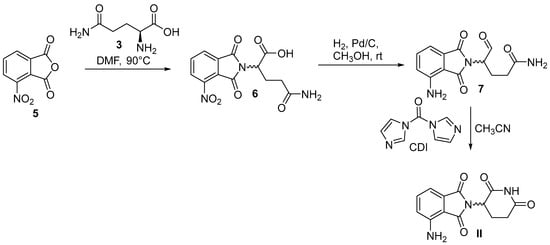
Scheme 3.
Synthesis of pomalidomide (II).
4. Apremilast
Like pomalidomide (II), the chemical structure of apremilast consists of an oxidized isoindoline heterocyclic core in which N is tethered with an alkyl fragment containing ether linkages and sulfone functionality. In addition, an N-acetyl group is substituted on the aromatic ring of the phthalimide moiety (Figure 2). Apremilast is indicated for the treatment of inflammatory conditions in patients with psoriasis.
4.1. Pharmacology of Apremilast
Sold under the brand name Otezla®, apremilast (III) is a non-steroidal anti-inflammatory drug (NSAID) used for the treatment of psoriasis, an inflammatory autoimmune disease. Psoriasis is a chronic skin condition that causes a rash of itchy and scaly patches on knees, elbows, trunk, and scalp. This medication is also prescribed for psoriatic arthritis in people commonly affected with psoriasis [30]. In fact, it is the first oral therapy to receive FDA approval for the treatment of adults with active psoriatic arthritis [30]. Quite recently, III was approved for the treatment of oral ulcers in another auto-immune condition called Behcet’s disease, which is associated with recurrent skin, blood vessel, and central nervous system inflammation [31]. Apremilast (III) administration induces a cascade of actions, decreasing the levels of inflammatory mediators responsible for inflammatory symptoms [32]. Phosphodiesterase 4 (PDE4) enzyme is one of the most important modulators of cyclic adenosine monophosphate (cAMP) signaling cascade. More precisely, III works by selectively inhibiting the PDE4 enzyme responsible for cAMP activity [32]. This leads to increased intracellular cAMP levels, controlling anti-inflammatory cytokine IL-10 and suppressing inflammation by decreasing the expression of TNF-α, IL, and other pro-inflammatory mediators [33]. The use of III also causes a decrease in pro-inflammatory nitric oxide synthase activity, which is responsible for the synthesis of nitric oxide. This prevents the trafficking of microphages and myeloid dendritic cells to the dermis and epidermis in psoriatic skin, thereby exhibiting anti-inflammatory activity.
4.2. Chemical Synthesis of Apremilast
The chemical synthesis of this highly functionalized racemic phthalidomide molecule, apremilast (III), was first reported in Celgene corporation via a convergent strategy (Scheme 4) [34]. In the first step, 3-ethoxy-4-methoxybenzaldehyde (8) was mixed with pre-formed lithium dimethyl sulfone, followed by the addition of lithium hexamethyldisilazide and boron trifluoride etherate to produce trimethylsilylated amine 9. The hydrolysis of 9 furnished 1-(3-ethoxy-4-methoxyphenyl)-2-(methyl sulfonyl)ethan-1-amine (10). Separately, 3-nitrophthalic acid (11) was reduced under catalytic hydrogenation conditions to 12, followed by its concomitant acetylation and condensation in refluxing acetic anhydride to yield acetylated phthalic anhydride 13. Finally, amine 10 was condensed with phthalic anhydride 13 in acetic acid at 110 °C to afford apremilast (III) as a racemate in 59% yield. Following this methodology, several strategies have been developed for the resolution of enantiomers of III, as well as for the synthesis of III in enantiomerically pure forms [34].
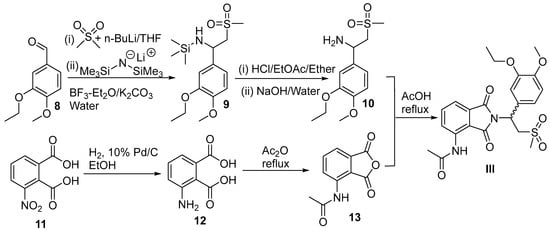
Scheme 4.
Synthesis of apremilast (III).
5. Phosmet
Phosmet (IV) also belongs to the thalidomide group of compounds containing isoindoline-1,3-dione heterocyclic core, in which N is tethered with a thiophosphate group (Figure 2). It is used as a pesticide against coddling moths.
5.1. Pharmacology of Phosmet
Unlike the thalidomide derivatives discussed above, phosmet (IV) is a non-systemic insecticide belonging to the organophosphate group of pesticides [35]. It is primarily used to control coddling moths in apple tree cultivation. It is also effective against aphids, suckers, mites, and fruit flies on fruit crops, ornamental plants, and vines. The insecticidal property of phosmet (IV) stems from its ability to inhibit acetylcholinesterase (AChE) activity by irreversibly phosphorylating the enzyme. AChE normally hydrolyzes the acetylcholine neurotransmitter to acetic acid and choline. Inhibition results in an excess of acetylcholine at the neuromuscular junction and synapses of the parasympathetic and sympathetic nervous systems, exerting neurotoxicity in both the central and peripheral nervous systems of pests [36].
5.2. Chemical Synthesis of Phosmet
The chemical synthesis of phosmet (IV) is outlined in Scheme 5. First, commercially available phthalimide (14) was N-chloromethylated in situ using aqueous formaldehyde (15) and hydrogen chloride gas to give N-chloromethylphthalimide (16). Finally, the nucleophilic substitution of chloride 16 with sodium dimethyldithiophosphorodithioate resulted in the formation of phosmet (IV) [37].

Scheme 5.
Synthesis of phosmet (IV).
6. Lenalidomide
Lenalidomide (V) is a derivative of thalidomide (I) in which the pyrrolidine ring of the isoindoline skeleton is only mono-oxidized. This partially oxidized heterocyclic core is referred as isoindolin-1-one. Like thalidomide (I), the N atom is substituted with a glutarimide moiety in lenalidomide (V, Figure 2). It is indicated for the treatment and maintenance therapy of adult patients with multiple myeloma.
6.1. Pharmacology of Lenalidomide
The drug lenalidomide (V) is sold under the name of Revlimid®. Similar to thalidomide (I), V is a cereblon modulator, a second-generation iMiD imide drug with potent antineoplastic, anti-angiogenic, and anti-inflammatory properties [38]. It is prescribed for the treatment of multiple myeloma, myelodysplastic syndromes, mantle cell lymphoma, follicular lymphoma, and marginal zone lymphoma [39]. It was envisaged that replacing the phthaloyl ring with isoindolinone ring will result in an increased stability of the molecule and may lead to its increased bioavailability [40]. Like thalidomide (I), lenalidomide (V) also exists as a racemic mixture of S (−) and R (+) forms. However, it is much more potent and safer than thalidomide (I) [20,41]. Nonetheless, the potential for teratogenic side effects still exists in lenalidomide (V) [42]. Patients must enroll in the lenalidomide REMS program to ensure contraception adherence during treatment [17].
Being an iMiD drug, lenalidomide (V) works through various mechanisms of action that promote malignant cell death and enhance host immunity [43]. The direct cytotoxicity of lenalidomide (V) is exerted by binding to the cereblon receptor, which increases apoptosis and inhibits the proliferation of hematopoietic malignant cells. It also limits the invasion or metastasis of tumor cells and inhibits angiogenesis [41,43]. Lenalidomide (V) exhibits indirect antitumor effects via its immunomodulatory actions by inhibiting the production of pro-inflammatory cytokines, regulating T-cell co-stimulation, and enhancing NK cells. It is estimated that lenalidomide (V) is about 100–1000 times more potent in stimulating T-cell proliferation than thalidomide (I) [41].
6.2. Chemical Synthesis of Lenalidomide
A concise synthesis of lenalidomide (V) was reported by Muller and co-workers (Scheme 6) [40]. The methodology involves the treatment of methyl (2-methyl-3-nitro)benzoate (17) with N-bromosuccinamide to obtain methyl 2-(bromomethyl-3-nitro)benzoate (18) first. Simultaneously, benzyloxycarbonyl (Cbz)-protected L-glutamine 19 was subjected to cyclization in the presence of CDI, followed by deprotection of the Cbz group by hydrogenolysis to produce 3-aminopiperidine-2,6-dione hydrochloride salt (20). The condensation of compound 18 and 20 in DMF yielded the nitro analog of V, 21. Finally, the nitro functionality of 21 was reduced to an amino group by a Pd/C-catalyzed hydrogenation step to furnish V as a racemate.

Scheme 6.
Synthesis of lenalidomide V.
7. Indoprofen
Like the profens, the chemical structure of indoprofen (VI) closely resembles that of the analgesic ibuprofen [44]. It consists of the oxidized isoindoline heterocycle, isoindolin-1-one, in which the N atom is tethered to 2-phenylpropanoic acid at the para position (Figure 2). Indoprofen has been indicated for the treatment of inflammatory conditions in arthritis patients.
7.1. Pharmacology of Indoprofen
Indoprofen (VI) is classified as an NSAID, and has anti-inflammatory and analgesic properties. It was used in rheumatoid arthritis, osteo-arthritis, and postoperative pain management [45]. Like any other NSAID, the mechanism of action for its anti-inflammatory effects involves the inhibition of cyclooxygenase (COX) enzymes [46]. In particular, indoprofen (VI) inhibits both isoforms of COX (COX-1 and COX-2), which reduces the production of prostaglandins, the mediators of inflammation. This mechanism also helps in reducing pain perception, and hence the drug exhibits analgesic and antipyretic (fever-reducing) effects. However, following several post-marketing reports of severe gastrointestinal bleeding, indoprofen (VI) was withdrawn worldwide from the market in the 1980s [47]. Interestingly, there has been a renewed interest in indoprofen (VI), as it is shown to be potentially beneficial for the treatment of spinal muscular atrophy, a fatal pediatric genetic disease, and overall muscle weakness [48].
7.2. Chemical Synthesis of Indoprofen
The synthesis of racemic indoprofen (VI) has been described in four steps, starting from 2-(4-nitrophenyl)propionate (22) [49,50]. More recently, a shortened three-step synthesis of VI with 41% overall yield was reported by Takahashi and co-workers in 2016, as depicted in Scheme 7 [51]. Compound 22 was initially subjected to 5% Pd/C-catalyzed hydrogenation conditions in ethanol to produce an aniline derivative, 23. A Mannich condensation between 23 and o-phthalaldehyde (24), in the presence of 1,2,3-1H-benzotriazole (Bt-H) and an excess of 2-mercaptoethanol (MET) in acetonitrile at room temperature, then resulted in indoprofen ethyl ester 25. Next, the base-mediated hydrolysis of 25 furnished indoprofen (VI).
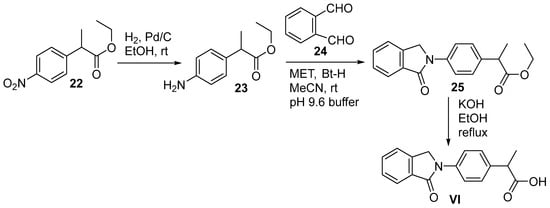
Scheme 7.
Synthesis of indoprofen (VI).
8. Chlorthalidone
The chemical structure of chlorthaliadone (VII) possesses an oxidized isoindoline core, isoindolin-1-one, which has aryl and hydroxy substitutions at position 3. The aryl group is further substituted with chloro and sulfonamide functionalities (Figure 2). This drug is indicated for the management of hypertension and edema.
8.1. Pharmacology of Chlorthalidone
Chlorthalidone (VII) is sold in the market under the trade names Edarbyclor®, Tenoretic®, and Thlitone®. It is classified as a diuretic used for the treatment of hypertension or high blood pressure. It is considered a first-line therapy for the management of uncomplicated hypertension, as it reduces the risk of stroke, myocardial infarction, and heart failure [52]. The drug VII is also prescribed for the management of edema caused by conditions such as heart failure or renal impairment [52]. The exact mechanism of action of chlorthalidone (VII) is under debate. However, it appears that VII improves blood pressure and swelling by preventing water absorption from the kidneys through the inhibition of the Na+/Cl− symporter membrane protein. This increased diuresis results in decreased plasma and extracellular fluid volumes, which ultimately leads to a reduction in blood pressure [53]. Furthermore, chlorthalidone (VII) has been shown to be effective in decreasing platelet aggregation, vascular permeability, and promoting angiogenesis. These pathways are presumed to be crucial in the cardiovascular risk reduction effects displayed by chlorthalidone (VII).
8.2. Chemical Synthesis of Chlorthalidone
The synthetic method for accessing chlorthalidone (VII) was first described by Graf and co-workers [54]. A number of patents also describe the synthesis of VII [55,56,57]. A recently described scalable improved process for preparing chlorthalidone (VII) with high purity is presented here (Scheme 8) [58]. Commercially available 2-(4-chlorobenzoyl)benzoic acid (26) was first reacted with hydroxylamine hydrochloride in the presence of NaOH in ethanol to produce benzoxazine-1-one (27). The treatment of compound 27 with zinc dust in acetic acid led to the formation of 3-(4′-chlorophenyl)phthalimidine (28) upon ring contraction. Subsequently, the reaction of 28 with chlorosulfonic acid in the presence of a chlorinating agent, phosphorus oxychloride, furnished a sulfonyl chloride intermediate, which was then subjected to aqueous ammonia in acetone to give the penultimate sulfonamide intermediate 29. Finally, a regioselective hydroxylation of isoindolin-1-one core at position 3, mediated by hydrogen peroxide and sodium hydroxide, resulted in chlorthalidone (VII) in 51% overall yield [58].
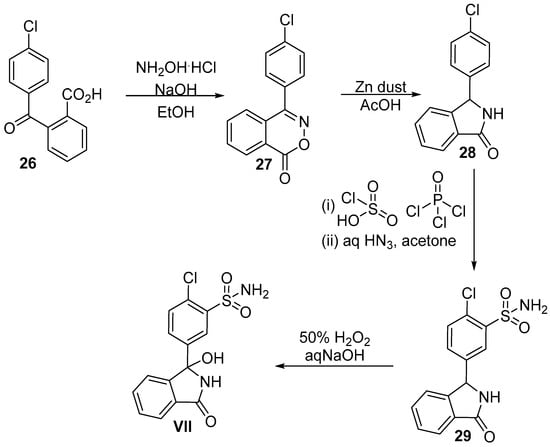
Scheme 8.
Synthesis of chlorthalidone (VII).
9. Midostaurin
Midostaurin (VIII) is an N-benzoyl derivative of the natural product staurosporine (30), isolated from Streptomyces staurosporeus [59]. It belongs to the indolocarbazole class of compounds. The chemical structure of VIII consists of an isoindolin-1-one core flanked by indole rings on both sides. The N atoms of the indole rings are attached to a single sugar unit (Figure 2). Midostaurin is indicated for the treatment of leukemia in adult patients.
9.1. Pharmacology of Midostaurin
Available under the brand name Rydapt®, midostaurin (VIII) is a multitarget kinase inhibitor antineoplastic agent used for the treatment of patients with newly diagnosed acute myeloid leukemia (AML) with a specific genetic mutation called FLT3 [59]. It is also used for aggressive systemic mastocytosis, systemic mastocytosis with associated hematologic neoplasm, and mast cell leukemia. Midostaurin (VIII) has been shown to increase the overall survival rate in patients with AML as an adjunct therapy along with chemotherapeutic agents [53]. Several reports have recognized that FLT3 mutations are an important prognostic factor in AML. Midostaurin (VIII) and its major active metabolites inhibit the activity of mutant FLT3 tyrosine kinases. Consequently, the inhibition of FLT3 receptor signaling cascades induces apoptosis in target leukemia cells expressing target receptors and mast cells, thus exhibiting antiproliferative activity [60].
9.2. Chemical Synthesis of Midostaurin
Midostaurin (VIII) has been synthesized semi-synthetically in a one-step reaction starting from the natural product staurosporine (30), as depicted in Scheme 9 [61]. Compound 30 can be conveniently obtained from the fermentation broth of marine bacterium Streptomyces staurosporeus culture [62]. The treatment of 30 with benzoic anhydride (31) in an ethanol/water mixture at 70 °C resulted in midostaurin (VIII) in 91.5% yield with high purity.
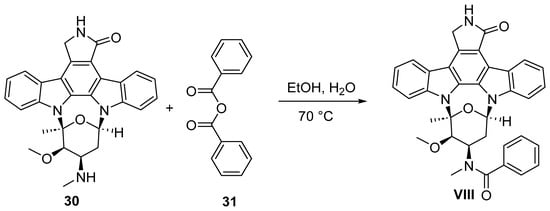
Scheme 9.
Synthesis of medostaurin (VIII).
10. Mazindol
The chemical structure of mazindol (IX) consists of isoindoline heterocycles fused with an additional five-membered N-containing ring between positions 1 and 2. In addition, the hydroxyl and 4-chlorophenyl groups are substituted at position 3 of the isoindoline skeleton (Figure 2). It is used in the short-term treatment of exogenous obesity in patients with risk factors such as hypertension, diabetes, and hyperlipidemia.
10.1. Pharmacology of Mazindol
Sold under the trade name Sanorex®, mazindol (IX) is a tricyclic sympathomimetic agent [63]. A sympathomimetic drug is a stimulant that mimics the effects of endogenous agonists of the sympathetic nervous system, such as catecholamines, norepinephrine, and dopamine. It was first approved by the FDA in 1973 for the treatment of obesity in adults. However, due to low sales, IX was voluntarily withdrawn from the market in the early 2000s. This drug is still approved in Mexico, Central America, Japan, and Argentina for short-term use in the treatment of obesity, in combination with lifestyle changes such as caloric restriction, exercise, and behavior modifications. Mazindol’s efficacy as an anti-obesity drug is due to its anorexigenic activity, that is, causing a loss of appetite. The suppression of appetite by IX is due to the inhibition of the feeding center of the lateral hypothalamus [64]. However, mazindol (IX) is only approved for the treatment of Duchenne muscular dystrophy (DMD) in the United States, a genetic condition that causes muscle weakness and heart problems in children [65]. Given the pharmacologic profile of IX, it is currently being investigated for efficacy in treating ADHD, schizophrenia, reducing cravings for the illicit drug cocaine, and neurobehavioral disorders [66,67,68].
10.2. Chemical Synthesis of Mazindol
The chemical synthesis of racemic mazindol (IX) has been reported by Aeberli and co-workers using a commercially available precursor, 2-(4-chlorobenzoyl)benzoic acid (26) [69]. First, the condensation of benzoic acid 26 with ethylenediamine by the azeotropic removal of water resulted in tricyclic product 32 in one step. Subsequently, reducing 32 with LiAlH4 in solvent THF led to the formation of carbinolamine 33a, which could not be isolated under these conditions. Compound 33a most likely undergoes a ring-opening skeletal rearrangement to 33b prior to undergoing aerial oxidation in THF/methanol, yielding a more stable product of mazindol (IX, Scheme 10).
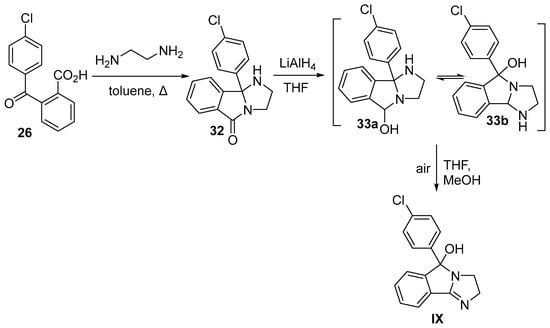
Scheme 10.
Synthesis of mazindol (IX).
11. Chlorisondamine
The chemical structure of chlorisondamine (X) consists of a perchlorinated isoindoline core with bis-quaternary ammonium centers (Figure 2). It has been used for the treatment of hypertension.
11.1. Pharmacology of Chlorisondamine
Classified as a nicotine receptor antagonist and ganglionic blocker, chlorisondamine (X) was developed for the treatment of hypertension in the 1950s under the trade name of ‘Ecolid’ [70]. The initial use of chlorisondamine (X) not only showed promise in reducing blood pressure, but also played an instrumental role in highlighting the importance of sympathetic activity in blood pressure. It was found to block ganglionic nicotinic receptors only temporarily, while showing negligible effects on the nicotinic receptors of the neuromuscular junction. Interestingly, chlorisondamine (X) has the ability to block most of the centrally mediated behavioral effects of nicotine. However, due to its polar bis-quaternary structure, it does not cross the blood–brain barrier readily. Therefore, a persistent blockade of nicotinic receptors is only possible when X is injected at a sufficiently high dose systemically. Chlorisondamine (X) was later withdrawn because it was not well tolerated and caused undesirable side effects [70]. Despite this, researchers continue to use chlorisondamine (X) to assess autonomic function and vasomotor sympathetic tone in animal models of hypertension [71].
11.2. Chemical Synthesis of Chlorisondamine
The synthesis of chlorisondamine (X) can be accomplished starting from commercially available tetrachlorophthal anhydride (34) in three steps, as described in Scheme 11 [72,73]. First, the condensation of 34 with N,N-dimethylethylenediamine produced N-alkylated phthalimide 35. The stepwise reduction of 35 with LiAlH4 then led to the formation of isoindoline intermediate 36. The permethylation of 36 in the presence of excess methyl chloride in DMF using a pressure bomb furnished X in a 36% overall yield [72,73].
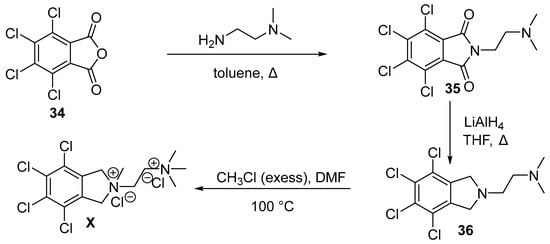
Scheme 11.
Synthesis of chlorisondamine (X).
12. Conclusions
The isoindoline substructure is found in naturally occurring alkaloids, as well as in synthetic drugs. Derivatives of isoindoline are known to exhibit diverse biological and pharmacological properties. Most importantly, several clinical drugs are known to possess isoindoline core. We have summarized the biological profiles, pharmacology, and chemical syntheses of ten isoindoline-based clinical drugs that have been approved or re-approved. Despite the withdrawal of some of these drugs from the marketplace, they are still the subject of intense research investigation in the current literature. Overall, the remarkable biological and medicinal properties of isoindoline-based molecules will continue to make them an attractive target for research and exploration.
Author Contributions
Conceptualization, M.J. and A.J.; literature review, M.J. and A.J.; writing-original draft preparation, H.S. and D.Y.; writing-review and editing, M.J. and A.J.; funding acquisition, M.J. All authors have read and agreed to the published version of the manuscript.
Funding
This research was funded by the Natural Sciences and Engineering Research Council of Canada (NSERC), grant number 2021-03869.
Acknowledgments
The author (M.J.) gratefully acknowledges the financial support provided by the Natural Sciences and Engineering Research Council of Canada (NSERC) to conduct this research.
Conflicts of Interest
The authors declare no conflicts of interest.
References
- Youssef, D.; Patel, R.; Mohapatra, P.; Jha, A. Pharmacology and synthesis of clinical drugs containing isoquinoline core. Trends Org. Chem. 2021, 21, 1–17. [Google Scholar]
- Kabir, E.; Uzzaman, M.A. A review on biological and medicinal impact of heterocyclic compounds. Results Chem. 2022, 4, 100606. [Google Scholar] [CrossRef]
- Ruiz, B.; Chávez, A.; Forero, A.; García-Huante, Y.; Romero, A.; Sánchez, M.; Rocha, D.; Sánchez, B.; Rodríguez-Sanoja, R.; Sánchez, S.; et al. Production of microbial secondary metabolites: Regulation by the carbon source. Crit. Rev. Microbiol. 2010, 36, 146–167. [Google Scholar] [CrossRef] [PubMed]
- Kaur, S.; Samota, M.K.; Choudhary, M.; Choudhary, M.; Pandey, A.K.; Sharma, A.; Thakur, J. How do plants defend themselves against pathogens-biochemical mechanisms and genetic interventions. Physiol. Mol. Biol. Plants 2022, 28, 485–504. [Google Scholar] [CrossRef] [PubMed]
- Han, Y.T.; Jung, J.W.; Kim, N.J. recent advances in the synthesis of biologically active cinnoline, phthalazine and quinoxaline derivatives. Curr. Org. Chem. 2017, 21, 1265–1291. [Google Scholar] [CrossRef]
- Clary, K.N.; Parvez, M.; Back, T.G. Preparation of 1-aryl-substituted isoindoline derivatives by sequential Morita–Baylis–Hillman and intramolecular Diels–Alder reactions. Org. Biomol. Chem. 2009, 7, 1226–1230. [Google Scholar] [CrossRef]
- Thakur, A.; Singh, A.; Kaur, N.; Ojha, R.; Nepali, K. Steering the antitumor drug discovery campaign towards structurally diverse indolines. Bioorg. Chem. 2020, 94, 103436. [Google Scholar] [CrossRef] [PubMed]
- Upadhyay, S.P.; Thapa, P.; Sharma, R.; Sharma, M. 1-Isoindolinone Scaffold-Based Natural Products with a Promising Diverse Bioactivity. Fitoterapia 2020, 146, 104722. [Google Scholar] [CrossRef]
- Heras Martinez, H.M.; Barragan, E.; Marichev, K.O.; Chávez-Flores, D.; Bugarin, A. Phthalimides as Anti-Inflammatory Agents. Future Med. Chem. 2025, 17, 125–142. [Google Scholar] [CrossRef] [PubMed]
- Starosotnikov, A.M.; Bastrakov, M.A. Cycloaddition reactions in the synthesis of isoindolines. Chem. Heterocl. Compd. 2017, 53, 1181–1183. [Google Scholar] [CrossRef]
- Williams, F.J.; Jarvo, E.R. Palladium-catalyzed cascade reaction for the synthesis of substituted isoindolines. Angew. Chem. Int. Ed. 2011, 50, 4459–4462. [Google Scholar] [CrossRef]
- Ward, S.P. Thalidomide and congenital abnormalities. Br. Med. J. 1962, 2, 646–647. [Google Scholar] [CrossRef] [PubMed]
- O’Brien, M.; Weagle, R.; Corkum, D.; Kuanar, M.; Mohapatra, P.P.; Jha, A. Convenient access to 5-arylisoindolo[2,1-a]quinolin-11(6aH)-ones. Mol. Divers. 2017, 21, 455–462. [Google Scholar] [CrossRef]
- Jha, A.; Chou, T.; ALJaroudi, Z.; Ellis, B.D.; Cameron, T.S. Aza-Diels–Alder reaction between N-aryl-1-oxo-1H-isoindolium ions and tert-enamides: Steric effects on reaction outcome. Beilstein J. Org. Chem. 2014, 10, 848–857. [Google Scholar] [CrossRef]
- Al-Jaroudi, Z.; Mohapatra, P.P.; Cameron, T.S.; Jha, A. Expedient and diastereoselective synthesis of substituted 6,6a-dihydroisoindolo[2,1-a]quinolin-11(5H)-ones. Synthesis 2016, 48, 4477–4488. [Google Scholar]
- Al-Jaroudi, Z.; Mohapatra, P.P.; Jha, A. Facile synthesis of 3-substituted isoindolinones. Tetrahedron Lett. 2016, 57, 772–777. [Google Scholar] [CrossRef]
- Brandenburg, N.A.; Bwire, R.; Freeman, J.; Houn, F.; Sheehan, P.; Zeldis, J.B. Effectiveness of risk evaluation and mitigation strategies (REMS) for lenalidomide and thalidomide: Patient comprehension and knowledge retention. Drug Saf. 2017, 40, 333–341. [Google Scholar] [CrossRef] [PubMed]
- Kim, J.H.; Scialli, A.R. Thalidomide: The tragedy of birth defects and the effective treatment of disease. Toxicol. Sci. 2011, 122, 1–6. [Google Scholar] [CrossRef] [PubMed]
- Ali, I.; Wani, W.A.; Saleem, K.; Haque, A. Thalidomide: A banned drug resurged into future anticancer drug. Curr. Drug Ther. 2012, 7, 13–23. [Google Scholar] [CrossRef]
- Anderson, K.C. Lenalidomide and Thalidomide: Mechanisms of action—Similarities and differences. Semin. Hematol. 2005, 42, S3–S8. [Google Scholar] [CrossRef] [PubMed]
- Krönke, J.; Udeshi, N.D.; Narla, A.; Grauman, P.; Hurst, S.N.; McConkey, M.; Svinkina, T.; Heckl, D.; Comer, E.; Li, X.Y.; et al. Lenalidomide causes selective degradation of IKZF1 and IKZF3 in multiple myeloma cells. Science 2014, 343, 301–305. [Google Scholar] [CrossRef] [PubMed]
- Majumder, S.; Sreedhara, R.C.; Banerjee, S.; Chatterjee, S. TNF-α signaling beholds thalidomide saga: A review of mechanistic role of TNF-α signaling under thalidomide. Curr. Top. Med. Chem. 2012, 12, 1456–1467. [Google Scholar] [CrossRef] [PubMed]
- Chamberlain, P.P.; Cathers, B.E. Cereblon Modulators: Low molecular weight inducers of protein degradation. Drug Discov. Today Technol. 2019, 31, 29–34. [Google Scholar] [CrossRef]
- Muller, G.W.; Konnecke, W.E.; Smith, A.M.; Khetani, V.D. A concise two-step synthesis of thalidomide. Org. Process. Res. Dev. 1999, 3, 139–140. [Google Scholar] [CrossRef]
- Shibata, N.; Yamamoto, T.; Toru, T. Synthesis of thalidomide. In Bioactive Heterocycles II; Eguchi, S., Ed.; Springer: Berlin/Heidelberg, Germany, 2007; pp. 73–97. [Google Scholar]
- Ribatti, D.; Vacca, A. Chapter 3—Anti-angiogenesis in multiple myeloma. In Anti-Angiogenesis Strategies in Cancer Therapeutics; Mousa, S.A., Davis, P.J., Eds.; Academic Press: Boston, MA, USA, 2017; pp. 39–50. [Google Scholar]
- Jaeger, H.K.; Davis, D.A.; Nair, A.; Shrestha, P.; Stream, A.; Yaparla, A.; Yarchoan, R. Mechanism and therapeutic implications of pomalidomide-induced immune surface marker upregulation in EBV-positive lymphomas. Sci. Rep. 2023, 13, 11596. [Google Scholar] [CrossRef] [PubMed]
- Chanan-Khan, A.A.; Swaika, A.; Paulus, A.; Kumar, S.K.; Mikhael, J.R.; Rajkumar, S.V.; Dispenzieri, A.; Lacy, M.Q. Pomalidomide: The new immunomodulatory agent for the treatment of multiple myeloma. Blood Cancer. J. 2013, 3, e143. [Google Scholar] [CrossRef]
- Ding, H.X.; Leverett, C.A.; Kyne, R.E.; Liu, K.K.; Fink, S.J.; Flick, A.C.; O’Donnell, C.J. Synthetic approaches to the 2013 new drugs. Bioorg. Med. Chem. 2015, 23, 1895–1922. [Google Scholar] [CrossRef]
- Fala, L. Otezla (Apremilast), an Oral PDE-4 inhibitor, receives fda approval for the treatment of patients with active psoriatic arthritis and plaque psoriasis. Am. Health. Drug Benefits 2015, 8, 105–110. [Google Scholar]
- Hatemi, G.; Mahr, A.; Takeno, M.; Kim, D.; Melikoğlu, M.; Cheng, S.; McCue, S.; Paris, M.; Chen, M.; Yazici, Y. Impact of apremilast on quality of life in Behçet’s syndrome: Analysis of the phase 3 RELIEF study. RMD Open 2022, 8, e002235. [Google Scholar] [CrossRef] [PubMed]
- Fertig, B.A.; Baillie, G.S. PDE4-mediated cAMP signalling. J. Cardiovasc. Dev. Dis. 2018, 5, 8. [Google Scholar] [CrossRef]
- Tong, B.N.; Liu, X.L.; Xiao, J.; Su, G.F. Immunopathogenesis of Behcet’s disease. Front. Immunol. 2019, 10, 665. [Google Scholar] [CrossRef]
- Narode, H.; Gayke, M.; Eppa, G.; Yadav, J.S. A review on synthetic advances toward the synthesis of apremilast, an anti-inflammatory drug. Org. Process Res. Dev. 2021, 25, 1512–1523. [Google Scholar] [CrossRef]
- Pohanish, R.P. (Ed.) Sittig’s Handbook of Pesticides and Agricultural Chemicals, 2nd ed.; William Andrew Publishing: Oxford, UK, 2015; pp. 629–724. [Google Scholar]
- Mensching, D.; Volmer, P.A. CHAPTER 125—Insecticides and Molluscicides. In Handbook of Small Animal Practice, 5th ed.; Morgan, R.V., Ed.; W.B. Saunders: Saint Louis, MO, USA, 2008; pp. 1197–1204. [Google Scholar]
- Müller, F.; Streibert, H.P.; Farooq, S. Acaricides. In Ullmann’s Encyclopedia of Industrial Chemistry; Woley-VCH Verlag GmbH & Co.: Weinheim, Germany, 2009; pp. 91–190. [Google Scholar]
- Qiao, S.K.; Guo, X.N.; Ren, J.H.; Ren, H.Y. Efficacy and safety of lenalidomide in the treatment of multiple myeloma: A systematic review and meta-analysis of randomized controlled trials. Chin. Med. J. 2015, 128, 1215–1222. [Google Scholar] [CrossRef] [PubMed]
- Arora, M.; Gowda, S.; Tuscano, J. A comprehensive review of lenalidomide in B-cell non-Hodgkin lymphoma. Ther. Adv. Hematol. 2016, 7, 209–221. [Google Scholar] [CrossRef]
- Muller, G.W.; Chen, R.; Huang, S.; Corral, L.G.; Wong, L.M.; Patterson, R.T.; Chen, Y.; Kaplan, G.; Stirling, D.I. Amino-substituted thalidomide analogs: Potent inhibitors of TNF-α production. Bioorg. Med. Chem. Lett. 1999, 9, 1625–1630. [Google Scholar] [CrossRef] [PubMed]
- Kotla, V.; Goel, S.; Nischal, S.; Heuck, C.; Vivek, K.; Das, B.; Verma, A. Mechanism of action of lenalidomide in hematological malignancies. J. Hematol. Oncol. 2009, 2, 36. [Google Scholar] [CrossRef]
- Hui, J.Y.; Fuchs, A.; Kumar, G. Embryo-fetal exposure and developmental outcome of lenalidomide following oral administration to pregnant cynomolgus monkeys. Reprod. Toxicolo. 2022, 114, 57–65. [Google Scholar] [CrossRef] [PubMed]
- Galustian, C.; Dalgleish, A. Lenalidomide: A Novel Anticancer Drug with Multiple Modalities. Expert Opin. Pharmacother. 2009, 10, 125–133. [Google Scholar] [CrossRef] [PubMed]
- Carroll, J. Better drug discovery through better target identification. Biotechnol. Healthc. 2005, 2, 52–58. [Google Scholar] [PubMed]
- Love, A.J.; Ripley, S.H.; Brock-Utne, J.G.; Blake, G.T. Indoprofen, a non-steroidal anti-inflammatory analgesic which does not depress respiration in normal man. A study comparing indoprofen with morphine. S. Afr. Med. J. 1985, 68, 801–802. [Google Scholar]
- Cashman, J.N. The mechanisms of action of NSAIDs in analgesia. Drugs 1996, 52 (Suppl. S5), 13–23. [Google Scholar] [CrossRef]
- Kim, H.; Cho, S.C.; Jeong, H.; Lee, H.; Jeong, M.; Pyun, J.; Ryu, D.; Kim, M.; Lee, Y.; Kim, M.S.; et al. Indoprofen prevents muscle wasting in aged mice through activation of PDK1/AKT pathway. J. Cachexia Sarcopenia Muscle 2020, 11, 1070–1088. [Google Scholar] [CrossRef] [PubMed]
- Lunn, M.R.; Root, D.E.; Martino, A.M.; Flaherty, S.P.; Kelley, B.P.; Coovert, D.D.; Burghes, A.H.; Man, N.T.; Morris, G.E.; Zhou, J.H.; et al. Indoprofen upregulates the survival motor neuron protein through a cyclooxygenase-independent mechanism. Chem. Biol. 2004, 11, 1489–1493. [Google Scholar] [CrossRef]
- Carney, R.W.J.; de Stevens, G. Tertiary Aminoacids. U.S. Patent 4,316,850, 23 February 1982. [Google Scholar]
- Nannini, G.; Giraldi, P.N.; Molgora, G.; Biasoli, G.; Spinelli, F.; Logemann, W.; Dradi, E.; Zanni, G.; Buttinoni, A.; Tommasini, R. New analgesic-anti-inflammatory drugs. 1-Oxo-2-substituted isoindoline derivatives. Arzneimittelforschung 1973, 23, 1090–1100. [Google Scholar] [PubMed]
- Takahashi, I.; Kawakami, T.; Hirano, E.; Kimino, M.; Kamimura, S.; Miwa, T.; Tamura, T.; Tazaki, R.; Kitajima, H.; Hatanaka, M.; et al. Application of the mild-condition phthalimidine synthesis with use of 1,2,3-1H-benzotriazole and 2-mercaptoethanol as dual synthetic auxiliaries. Effective synthesis of phthalimidines possessing a variety of substituents at 2-position. Heterocycles 2016, 93, 557–571. [Google Scholar] [CrossRef] [PubMed]
- Wright, J.M.; Lee, C.H.; Chambers, G.K. Systematic review of antihypertensive therapies: Does the evidence assist in choosing a first-line drug? Can. Med. Assoc. J. CMAJ 1999, 161, 25–32. [Google Scholar]
- Shahin, M.H.; Johnson, J.A. Mechanisms and pharmacogenetic signals underlying thiazide diuretics blood pressure response. Curr. Opin. Pharmacol. 2016, 27, 31–37. [Google Scholar] [CrossRef]
- Graf, W.; Girod, E.; Schmid, E.; Stoll, W.G. Zur Konstitution von Benzophenon-2-carbonsäure-Derivaten. Helv. Chim. Acta 1959, 42, 1085–1101. [Google Scholar] [CrossRef]
- Wilfried, G.; Erich, S.; Stoll, W.G. New Isoindoline Derivatives. U.S. Patent 3,055,904, 25 September 1962. [Google Scholar]
- Golec, F.A., Jr.; Auerbach, J. Intermediates for the Synthesis of Phthalimidines. U.S. Patent 4331600, 25 May 1982. [Google Scholar]
- Kumar, A.; Singh, D.; Jadhav, A.; Pandya, D.N. An Efficient Industrial Process for 3-hydroxy-3(3′-sulfamyl-4′-chlorophenyl)phtalimidine. International Patent Application Publication WO2005065046, 21 July 2005. [Google Scholar]
- Gadakar, M.; Wagh, G.; Wakchaure, Y.; Thanasekaran, P.; Punde, D. Improved Process for the Preparation of Chlorthalidone. International Patent Application Publication WO2018158777, 7 September 2018. [Google Scholar]
- Manley, P.W.; Weisberg, E.; Sattler, M.; Griffin, J.D. Midostaurin, a Natural Product-Derived Kinase Inhibitor Recently Approved for the Treatment of Hematological Malignancies. Biochemistry 2018, 57, 477–478. [Google Scholar] [CrossRef]
- Stone, R.M.; Manley, P.W.; Larson, R.A.; Capdeville, R. Midostaurin: Its odyssey from discovery to approval for treating acute myeloid leukemia and advanced systemic mastocytosis. Blood Adv. 2018, 2, 444–453. [Google Scholar] [CrossRef] [PubMed]
- Liang, X.; Yang, Q.; Wu, P.; He, C.; Yin, L.; Xu, F.; Yin, Z.; Yue, G.; Zou, Y.; Li, L.; et al. The synthesis review of the approved tyrosine kinase inhibitors for anticancer therapy in 2015–2020. Bioorg. Chem. 2021, 113, 105011. [Google Scholar] [CrossRef]
- Li, G.; Wu, D.; Xu, Y.; He, W.; Wang, D.; Zhu, W.; Wang, L. Synthesis and Antitumor Activity of Staurosporine Derivatives. Nat. Prod. Commun. 2022, 17, 1934578X2211030361. [Google Scholar] [CrossRef]
- Gonçalves, C.L.; Scaini, G.; Rezin, G.T.; Jeremias, I.C.; Bez, G.D.; Daufenbach, J.F.; Gomes, L.M.; Ferreira, G.K.; Zugno, A.I.; Streck, E.L. Effects of acute administration of mazindol on brain energy metabolism in adult mice. Acta Neuropsychiatr. 2014, 26, 146–154. [Google Scholar] [CrossRef] [PubMed]
- Inoue, S. Clinical Studies with Mazindol. Obes. Res. 1995, 3, 549S–552S. [Google Scholar] [CrossRef] [PubMed]
- Mazindol. DrugBank Online. Available online: https://go.drugbank.com/drugs/DB00579 (accessed on 11 March 2024).
- Seibyl, J.P.; Krystal, J.H.; Charney, D.S. Dopamine and Noradrenergic Reuptake Inhibitors in Treatment of Schizophrenia. U.S. Patent 5,447,948, 5 September 1995. [Google Scholar]
- Berger, S.P. Dopamine Uptake Inhibitors in Reducing Substance Abuse and/or Craving. U.S. Patent 5,217,987, 8 June 1993. [Google Scholar]
- Kovacs, B.; Pinegar, L. Use of Isoindoles for the Treatment of Neurobehavioral Disorders. International Patent Application Publication WO2009155139, 12 April 2009. [Google Scholar]
- Aeberli, P.; Eden, P.; Gogerty, J.H.; Houlihan, W.J.; Penberthy, C. 5-aryl-2,3-dihydro-5H-imidazo[2,1-a]isoindol-5-ols. novel class of anorectic agents. J. Med. Chem. 1975, 18, 177–182. [Google Scholar] [PubMed]
- Bakke, J.L.; Darvill, F.T. Chlorisondamine (ecolid) chloride in medical treatment of severe hypertension. J. Am. Med. Assoc. 1957, 163, 429–436. [Google Scholar]
- Souza, L.A.; Cooper, S.G.; Worker, C.J.; Thakore, P.; Feng Earley, Y. Use of chlorisondamine to assess the neurogenic contribution to blood pressure in mice: An evaluation of method. Physiol. Rep. 2021, 9, e14753. [Google Scholar] [CrossRef] [PubMed]
- Rosen, W.E.; Toohey, V.P.; Shabica, A.C. Tetrachloroisoindolines and related systems. alkylation reactions and inductive Effects. J. Am. Chem. Soc. 1957, 79, 3167–3174. [Google Scholar] [CrossRef]
- Zezula, J.; Wang, H.J.; Woods, A.S.; Wise, R.A.; Jacobson, A.E.; Rice, K.C. The high specific activity tritium labeling of the ganglion-blocking nicotinic antagonist chlorisondamine. J. Label Compd. Radiopharm. 2006, 49, 471–478. [Google Scholar] [CrossRef]
Disclaimer/Publisher’s Note: The statements, opinions and data contained in all publications are solely those of the individual author(s) and contributor(s) and not of MDPI and/or the editor(s). MDPI and/or the editor(s) disclaim responsibility for any injury to people or property resulting from any ideas, methods, instructions or products referred to in the content. |
© 2025 by the authors. Licensee MDPI, Basel, Switzerland. This article is an open access article distributed under the terms and conditions of the Creative Commons Attribution (CC BY) license (https://creativecommons.org/licenses/by/4.0/).